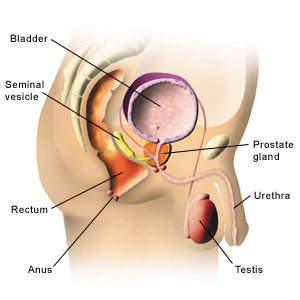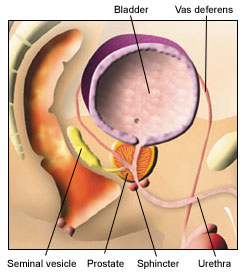Download our printable PDF booklets to read offline.
Prostate Cancer General information
Use our treatment selector to get an idea of what treatment is right for you.
Select this link to view the treatment selector
ŠThe Prostate Cancer Centre UK Ltd 2005. All rights reserved.

Information on the prostate gland, where it is and what it does.
The prostate is a small gland about the size of a walnut, which lies just below the bladder. The tube draining the bladder, called the urethra, passes through the centre of the gland to the penis.
The valve mechanism, or sphincter, maintains continence and stop urine leaking out of the bladder. It is located below the prostate gland.

The prostate gland is part of the male reproductive system. It develops at puberty and continues to enlarge throughout life.
The prostate gland acts rather like a junction box. It allows the tubes that transport sperm from each testicle, and the tubes that drain from the seminal vesicles to meet and then empty their contents in to the urethra. (The seminal vesicles consist of two pouches that provide nutrients for the sperm and lie immediately behind the prostate).
At the point of orgasm sperm, seminal vesicle fluid and prostatic secretions enter the urethra and mix together forming semen. This is then ejaculated out through the penis by rhythmic muscular contractions.

The growth of the prostate is controlled by testosterone, the male sex hormone. Most testosterone is made by the testicles, although a small amount is also made by the adrenal glands, which lie on top of each kidney. The hormone enters the blood stream and works its way to the prostate. Here it is changed in to dihydrotestosterone (DHT), a more active form of testosterone, that stimulates growth of the gland.
The prostate gradually enlarges with ageing under the influence of DHT resulting in symptoms such as a reduced urinary flow and a feeling of incomplete emptying of the bladder having just passed urine. This enlargement is entirely normal and usually benign (non-cancerous).
Now that you have taken a look at the position and function of the prostate, we would suggest that your next step is to visit the What is prostate cancer? section. Here you will find out more about prostate cancer, its causes, terminology and other information.
![Prostate Cancer Centre logo [link to home page]](images/interface/PCClogo_top.gif)





